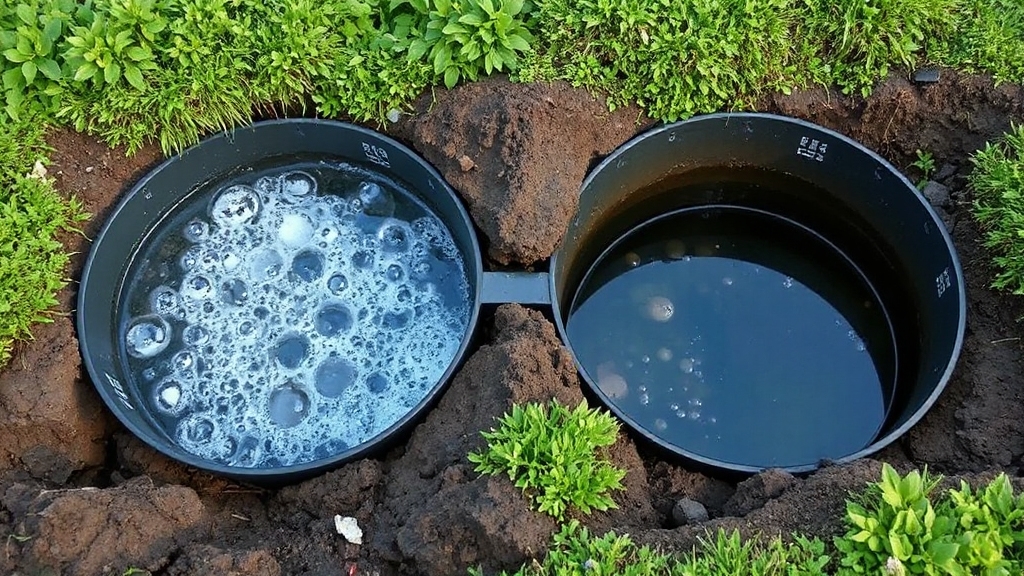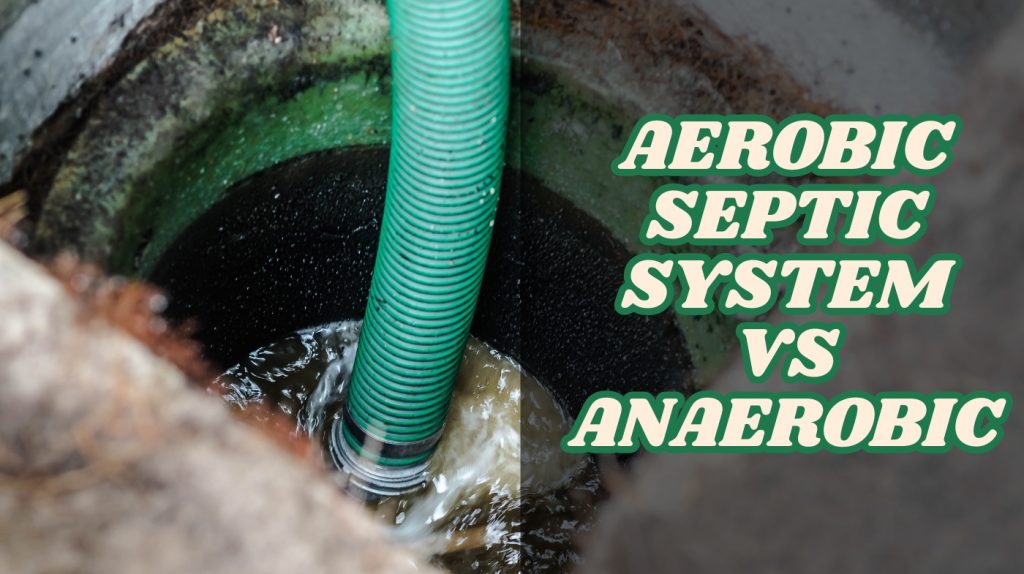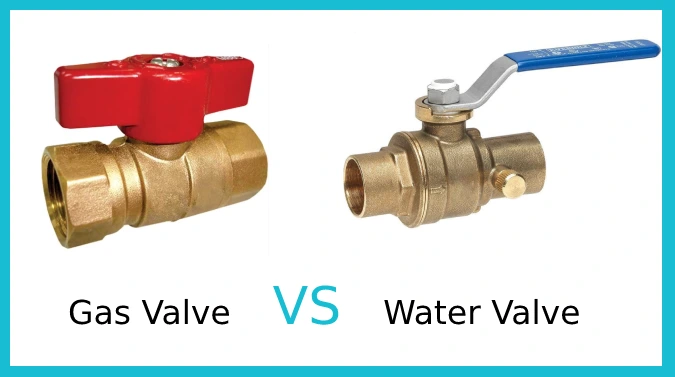Last Updated on July 2, 2025
You’ll find aerobic septic systems use oxygen to rapidly break down waste, yielding cleaner, less odorous effluent and better pathogen reduction, ideal for dense soils or high water tables.
Anaerobic systems rely on slower, oxygen-free digestion, producing stronger odors and higher organic loads, suited for permeable soils with lower costs and simpler maintenance.
While aerobic units cost more upfront and need electricity, they offer superior environmental protection. Exploring deeper reveals how installation, upkeep, and site factors influence your most suitable choice.
Key Takeaways
- Aerobic systems use oxygen to rapidly decompose waste, producing cleaner effluent and reducing pathogens, while anaerobic systems rely on slow, oxygen-free digestion.
- Aerobic septic systems are suitable for dense soils and high water tables; anaerobic systems require permeable soils and are better for rural, well-drained areas.
- Aerobic systems have higher installation and maintenance costs due to mechanical components and energy use, whereas anaerobic systems are simpler and more affordable initially.
- Aerobic systems need regular inspections and component replacements, incurring higher operational expenses; anaerobic systems require minimal maintenance mainly limited to periodic pumping.
- Aerobic systems offer superior environmental protection by minimizing odors, pathogens, and pollution risks compared to the slower, odor-prone anaerobic systems.
Comparison Table of Aerobic Septic System vs Anaerobic
| Feature | Aerobic Septic System | Anaerobic Septic System |
|---|---|---|
| Treatment Process | Uses oxygen for rapid waste breakdown | No oxygen; slower waste digestion |
| Effluent Quality | Cleaner, less odorous, fewer pathogens | More contaminants, stronger odor |
| Installation Cost | Higher ($10,000–$20,000+) | Lower ($3,000–$8,000) |
| Maintenance | Frequent, specialized, needs electricity | Minimal, periodic pumping, no electricity |
| Best For | Dense soils, high water table, sensitive sites | Well-drained, rural, permeable soils |
How Aerobic and Anaerobic Systems Work?
While both aerobic and anaerobic septic systems treat wastewater on-site, they operate through fundamentally different biological processes and structural designs that affect their efficiency and maintenance requirements.
In aerobic systems, you’ll find four compartments: a trash tank for solid-liquid separation, an aerobic tank supplying oxygen to bacteria that rapidly oxidize organic matter, a pump tank to move effluent, and a disinfection unit using chlorinators or UV light.
This oxygen-rich environment accelerates waste breakdown and reduces nitrogen compounds. The aeration chamber relies on a small compressor to introduce oxygen from a compressor, which is essential for sustaining the aerobic microbial activity.
These systems require regular maintenance to prevent issues such as mineral scale buildup that can impair performance.
In contrast, anaerobic systems rely on bacteria digesting waste without oxygen inside a septic tank, resulting in slower digestion and byproducts like methane causing odors.
Anaerobic effluent is less treated, requiring larger leach fields, while aerobic systems need electrical components and routine disinfection to maintain microbial balance and functionality.
Comparing Treatment Efficiency and Output Quality
Because aerobic and anaerobic septic systems rely on distinct biological processes, their treatment efficiency and output quality differ considerably.
Aerobic systems use oxygen-dependent bacteria, achieving over 90% waste reduction, producing cleaner, less odorous effluent suitable for sensitive environments.
Anaerobic systems operate without oxygen, resulting in slower waste breakdown and higher contaminant levels, relying on soil filtration for further treatment.
Proper soil assessment is essential to determine which system is most suitable for a given location, as soil type directly impacts system performance and longevity (soil conditions).
| Feature | Aerobic System | Anaerobic System |
|---|---|---|
| Treatment Efficiency | >90% waste reduction | Lower, slower decomposition |
| Effluent Quality | Low organic matter, disinfected | Higher contaminants, odorous |
| Environmental Impact | Better groundwater protection | Depends on soil filtration |
| Volume Capacity | Handles larger wastewater volumes | Limited by soil/drain field size |
| Maintenance Complexity | Requires electrical components | Simpler, more reliant on nature |
Cost Differences Between Aerobic and Anaerobic Systems
You’ll notice aerobic systems require a considerably higher initial investment than anaerobic ones due to added mechanical components and installation complexity. Proper disassembly procedures are essential during maintenance to ensure system longevity and performance.
Maintenance costs also differ, with aerobic setups demanding more energy and servicing over time. Evaluating long-term financial impact means balancing upfront expenses against potential savings from extended lifespan and regulatory compliance.
Anaerobic systems are more affordable for homeowners and typically have lower maintenance costs, making them a popular choice for budget-conscious clients.
Installation Cost Comparison
Installing a septic system typically involves a significant financial commitment, with costs varying greatly between aerobic and anaerobic options.
Anaerobic systems generally range from $3,000 to $8,000 due to simpler designs and lower labor demands. Material choice impacts cost significantly; for example, fiberglass tanks used in aerobic systems typically cost between $1,200 and $2,000, offering durability and resistance to cracking.
Additionally, the energy consumption of aerobic systems tends to be higher due to their reliance on electrical aerators.
In contrast, aerobic systems, incorporating oxygen aerators, electrical components, and often fiberglass tanks, can cost between $10,000 and $20,000, with specialized units reaching $50,000.
Excavation and site preparation expenses also differ; anaerobic systems usually require larger drain fields, increasing land and landscaping costs. Conversely, aerobic systems have smaller footprints but add expenses for protective enclosures and electrical hookups.
Furthermore, aerobic installations demand specialized labor with higher rates, reflecting system complexity. Additionally, labor costs typically account for 50–70% of the total system cost, influencing overall expenditure significantly.
Maintenance Expense Variations
While upfront costs differ markedly between aerobic and anaerobic septic systems, ongoing maintenance expenses play a pivotal role in total ownership cost. Aerobic systems demand higher inspection frequency, aerator pump energy, and component replacements, increasing annual expenses.
Anaerobic systems incur lower inspection and energy costs due to simpler mechanics. It is important to note that the working components in each system influence these maintenance demands.
Consider the comparison below:
| Expense Category | Aerobic System Cost | Anaerobic System Cost |
|---|---|---|
| Pumping (annualized) | ~$60 | ~$60 |
| Inspection Frequency/Cost | Annual, $200–$800 | Less frequent, lower cost |
| Energy Consumption | $120–$300 annually | Negligible |
| Component Replacement | $100–$600 occasionally | Minimal |
| Maintenance Contracts | ~$250+ annually | Typically none or minimal |
You’ll find aerobic systems demand more maintenance investment, reflecting operational complexity and energy use. Additionally, aerobic systems with NSF 40 certification require bi-annual inspections costing about $60 annually, contributing to the total maintenance costs over time.
Long-Term Financial Impact
Because aerobic septic systems incorporate more advanced mechanical components, their initial installation costs typically range from $10,000 to $20,000 or more, substantially exceeding the $3,000 to $8,000 range for anaerobic systems.
Ensuring proper electrical connections during installation is crucial for system reliability and safety. While anaerobic systems have lower upfront expenses, they generally require more frequent replacements or upgrades, increasing long-term costs.
Aerobic systems’ enhanced efficiency and longer lifespan can delay costly full replacements, reducing cumulative expenses over time. Additionally, aerobic systems mitigate risks of environmental penalties and costly soil remediation, which anaerobic systems may incur due to inefficiencies.
Regulatory preferences for aerobic technology can lead to higher initial compliance costs but offer financial advantages by avoiding future upgrades and fines.
When evaluating long-term financial impact, you should consider installation, maintenance, regulatory, and replacement expenses to determine the most cost-effective solution.
The choice of system also depends on property size, soil conditions, and efficiency needs, which affect overall expenses and performance system choice factors.
Environmental Suitability and Conditions for Each System
You’ll need to evaluate soil permeability and groundwater levels to determine which septic system suits your site. Space constraints and location characteristics also influence whether aerobic or anaerobic systems perform at their best.
Additionally, consider how each system’s effluent quality and operational demands impact local environmental conditions and regulatory compliance. Regular maintenance is essential to ensure the system functions efficiently and avoids costly repairs or environmental hazards.
Addressing potential issues such as sediment buildup can help maintain system performance and prevent complications.
Soil and Water Compatibility
When evaluating soil and water compatibility for septic systems, you must consider the distinct environmental requirements and performance characteristics of aerobic and anaerobic systems.
Aerobic systems excel in poorly permeable soils, such as dense clay or areas with high water tables, thanks to oxygen injection that boosts microbial breakdown and produces higher quality effluent with reduced pathogens.
This enhances soil conditions and lowers contamination risks, especially near sensitive groundwater. They also use less yard space, making them attractive for residential development and outdoor landscaping.
Additionally, these systems often incorporate chlorine injection systems to ensure effective disinfection of treated wastewater before disposal.
Anaerobic systems, however, require permeable soils to facilitate natural effluent percolation and biological activity, limiting their use to well-drained environments. Without oxygen, anaerobic systems yield slower decomposition and higher organic loads, increasing potential groundwater pollution.
Aerobic treatment improves nutrient cycling by reducing nitrogen and phosphorus loading, thereby better protecting soil and water quality in diverse environmental settings. Additionally, proper operation and maintenance minimize the risk of surface water contamination from treated wastewater.
Space and Location Needs
Although aerobic and anaerobic septic systems serve similar functions, their space and location requirements differ considerably due to operational and environmental factors.
You’ll find aerobic systems need watertight units, aeration tanks, and accessible maintenance space, often suitable for limited or poor soil sites but requiring power and precise installation.
Anaerobic systems, buried underground, demand level ground with suitable soil percolation, ample land for drain fields, and no electricity, favoring rural or off-grid areas.
| Aspect | Aerobic System | Anaerobic System |
|---|---|---|
| Space Requirement | Larger, includes aeration tanks | Smaller, underground tanks |
| Soil Suitability | Poor soils acceptable | Requires permeable soils |
| Location Flexibility | Moderate, needs power access | High, no power needed |
| Maintenance Access | Required, accessible location | Minimal, buried |
| Regulatory Setbacks | Often stricter, similar or greater clearance | Standard clearances per local codes |
Proper maintenance of septic systems often involves monitoring components like the float switch mechanism to ensure reliable operation and prevent failures.
Environmental Impact Considerations
Since environmental impact hinges on wastewater treatment efficiency and site conditions, aerobic and anaerobic septic systems differ markedly in suitability and outcomes.
You’ll find aerobic systems excel in high water table areas, producing cleaner effluent that minimizes groundwater contamination risks and reduces odor emissions. Their enhanced treatment lowers nitrogen, phosphorus, and pathogen loads, protecting surface waters and soil chemistry.
Additionally, aerobic systems help prevent algae blooms by reducing nutrient discharge into nearby lakes and rivers. However, aerobic units demand regular maintenance to sustain environmental benefits.
Conversely, anaerobic systems rely on natural bacterial processes without oxygen, often yielding effluent with higher contaminant concentrations.
These systems suit rural settings with ample soil for filtration but pose greater groundwater and surface water pollution risks if poorly maintained or failing.
You must consider site-specific conditions and maintenance capacity to select a system that aligns with environmental protection goals effectively.
Maintenance Needs and System Complexity
Because aerobic septic systems incorporate multiple mechanical components like aerators, pumps, and chlorinators, they demand more frequent and specialized maintenance compared to anaerobic systems.
You’ll need to schedule inspections every 3 to 4 months, maintain operation contracts with certified providers, and monitor system-specific parts regularly. Regular inspection & maintenance is essential to extend the lifespan of aerobic systems.
These mechanical parts are subject to wear and may require replacement due to mechanical vibration and pressure fluctuations. Aerobic septic systems need frequent inspections and specialized care due to their mechanical components.
In contrast, anaerobic systems require less frequent checks and simpler servicing. Key distinctions include:
- Aerobic systems require routine cleaning of effluent filters and monitoring of oxygen levels.
- Pumps and chlorinators need periodic inspection and possible part replacement.
- Anaerobic systems rely on sludge measurement and tank pumping every 3 to 5 years.
- Aerobic systems involve higher maintenance costs due to complexity and certified technician requirements.
Impact on Odor and Surrounding Environment
Maintenance demands can influence how well a septic system controls odors and limits environmental impact.
Aerobic systems, with oxygen-rich environments, reduce odor-causing compounds and emit fewer foul gases than anaerobic systems, which generate methane and hydrogen sulfide, leading to strong odors and air quality concerns.
Additionally, aerobic systems produce cleaner effluent, minimizing soil and groundwater contamination, while anaerobic effluent poses higher risks of nutrient leaching and ecosystem disruption.
Proper disposal methods include using sewer drains or septic tanks to mitigate environmental risks. Aerobic septic systems are suitable for high water tables, making them a versatile option in various environmental conditions.
Installation Considerations and Space Requirements

When planning your septic system installation, evaluating site-specific factors such as soil characteristics, water table depth, and spatial constraints is vital. These details influence system choice, design, and regulatory compliance. Consider the following:
- Conduct soil percolation tests and assess water table depth to determine suitable system type and drainfield size.
- Aerobic systems need well-drained soils and extra space for multiple tanks and aeration units; anaerobic systems tolerate less permeable soils but require larger drainfields. Additionally, site evaluation processes including soil assessments are essential to ensure system suitability and prevent contamination.
- Obtain required permits with detailed site plans and factor in inspections to meet local codes.
- Ensure adequate clearance for installation equipment, maintenance access, and setbacks from wells, buildings, and property lines to prevent contamination and allow future expansion.
Long-Term Benefits and Challenges of Each System
Choosing the right septic system goes beyond installation—it considerably affects long-term performance and sustainability. Aerobic systems provide superior effluent quality, extending drainfield life and reducing environmental risks.
However, they demand more maintenance, have higher costs, and rely on electricity. Anaerobic systems offer simplicity, lower costs, and energy independence but generate poorer effluent, increasing clogging risks and environmental impact.
Additionally, aerobic systems are less prone to odors because of the efficient waste breakdown in an oxygen-rich environment.
| Aspect | Aerobic System | Anaerobic System |
|---|---|---|
| Effluent Quality | Cleaner, safer for environment | Higher organic/pathogen content |
| Maintenance | Frequent, mechanical parts | Lower, simpler design |
| Operational Cost | Higher, due to power use | Lower, passive operation |
Frequently Asked Questions
Can Aerobic Systems Be Converted From Existing Anaerobic Tanks?
You’d be amazed to know you can turn your old anaerobic tank into a powerhouse aerobic system! By installing aeration equipment like air pumps and diffusers, you introduce oxygen that revitalizes bacterial activity, boosting organic matter breakdown twentyfold.
This retrofit improves effluent quality, reduces biomat buildup, and extends system life—all without replacing your tank. Just make certain continuous power and proper installation for maximum performance. It’s a smart, cost-effective upgrade you shouldn’t overlook.
What Is the Typical Lifespan of Aerobic Versus Anaerobic Septic Systems?
You can expect aerobic septic systems to last around 15 to 20 years typically, with tanks reaching up to 40 years if maintained well, including compressor servicing every 3 to 5 years.
Anaerobic systems generally last 20 to 40 years, though their drain fields may fail sooner, around 15 to 25 years. Proper maintenance, inspections, and environmental factors considerably influence both systems’ longevity and performance.
Are There Specific Permits Required for Installing Aerobic Systems?
Before you dig, remember: permits aren’t just paperwork they’re your green light. You need specific permits from local health or environmental authorities before installing aerobic septic systems. These require thorough site evaluations, detailed design plans, and soil testing by licensed professionals.
Permits guarantee your system meets safety and environmental standards. Only certified installers can proceed, and inspections follow installation to confirm compliance. Skipping permits risks legal and functional problems.
How Do Weather Conditions Affect Aerobic System Performance?
You’ll find that weather conditions greatly impact aerobic system performance. Heavy rain saturates soil, reducing absorption and causing backups. Drought compacts soil, hindering filtration and increasing clogging risks.
Temperature extremes stress aerobic microbes essential for treatment, with heat raising oxygen demand and cold freezing soil absorption. Rapid temperature shifts may damage components.
To maintain efficiency, you must manage drainage, prevent soil compaction, and protect microbial health during weather fluctuations.
Can Household Chemicals Harm Aerobic Septic System Bacteria?
You know what they say: “Don’t throw the baby out with the bathwater.” Household chemicals like bleach, ammonia, and antibacterial cleaners kill the beneficial bacteria crucial for breaking down waste in your septic system.
Using harsh detergents, pesticides, or medications disrupts microbial balance, causing sludge buildup and reduced efficiency. To protect your system, minimize chemical use, choose septic-safe products, and avoid disposing of pharmaceuticals down the drain to maintain ideal bacterial health.
Odor Control and Pathogen Reduction: Choosing for Health & Environment
When choosing between aerobic and anaerobic septic systems, you must weigh treatment efficiency, cost, and environmental impact carefully.
Aerobic systems offer superior effluent quality but require more maintenance and space, while anaerobic systems are simpler and cheaper but less effective. Considering your site conditions and long-term goals is vital.
So, which system truly balances performance with practicality for your needs? Making an informed choice guarantees ideal wastewater management and environmental protection.



